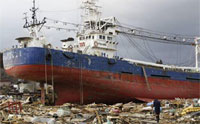 “The newest landmark in the tsunami-stricken city of Kesennuma.”
“The newest landmark in the tsunami-stricken city of Kesennuma.”
Ghost ship haunts tsunami-hit Japanese city
The newest landmark in the tsunami-stricken city of Kesennuma is a massive fishing trawler that was swept up at sea and came to rest on one of the main roads to City Hall. The No. 18 Kyotoku-maru ship, with a red and blue hull and a “safety first” slogan painted just above its bridge, looms over a landscape of homes and business splintered by the March 11 tsunami and then set ablaze in an ensuing fire.
“It really catches the eye,” said Ayaka Hatakeyama, who used to run a butcher shop a few metres from where the ship came to rest in the centre of this northeastern port city.
The ship stands out in an already surreal landscape of convenience stores smashed by houses and cars perched precariously on crumbling concrete walls.
Locals share stories about the ship whose crew was forced to stay on board as the city beneath them blazed through the night.
“We heard the ship was full of fuel and worried that it was going to explode,” Hatakeyama said as she took a break from salvaging goods from her store.
The central business district of the city of 73,000 was ravaged by the tsunami that filled streets with water two-floors high and parked smaller ships haphazardly in other locations.
But the Kyotoku-maru will likely stay where it now sits as a ghost ship for some time to come, with officials expecting it to take months just to remove the debris caused by the tsunami.
“I have no idea how they are going to get that thing out of here,” one fire-fighter said.

Salvaging goods from her store?
Everything is radioactive, there is nothing to salvage or loot, its all contaminated.
Wall Street Journal:
Looting Rears Its Head in Japan – WSJ.com
Mar 23, 2011 … Despite the lack of food and other necessities in Japan’s hardest-hit areas, there has been little sign of looting, though there is some …
http://online.wsj.com/article/SB10001424052748703410604576216293024644156.html
In my Blog NAUTICAL LOG I have not posted about the earthquake, tsunami, or the nuclear event. Statements such as “everything is radioactive—all is contaminated” are not accurate or helpful to this situation. The media reporting is wild enough as it is on all channels. Where is Kesennuma in relation to the nuclear plant?
Good Watch
Kesennuma is considerably north of the nuclear plants. So far at least, there have been no reports of elevated levels of radiation in Kesennuma. Many remain concerned nevertheless.
In Japan, fishermen fear spread of radiation scare
“Now Kondou and others in Kesennuma worry that radiation from the seaside nuclear plant might also affect the region’s long-bustling fishing industry, which provides tuna, oysters, shark, squid and seaweed to restaurants and supermarkets throughout Japan and around the world.
Japanese officials this week said they have detected higher than normal radiation levels in samples of seawater around the power complex. Kondou is concerned that dangerous isotopes might soon infect the huge schools of tuna he reels onto his trawler, the 31 Kohei Maru.
“I worry the radiation might move up the food chain,” says Kondou, 40, who was more than 300 miles from shore searching for fish when the quake struck on March 11. “At first, the smaller fish will become infected and then will get eaten by the bigger fish.”
While the alarm is understandable, the science of radiation contamination suggests the health risks are less scary. Dr. Andrew Maidment, associate professor of radiology at the Hospital of the University of Pennsylvania, says radiation will be very heavily diluted in the large expanse of seawater off Japan’s northeast coast, though inland fisheries such as shallow water fish farms might face a slightly higher risk of contamination.
Pingback: One Year After the Tsunami – No.18 Kyotoku-maru, Remains As Tsunami Monument or Scar | Old Salt Blog – a virtual port of call for all those who love the sea